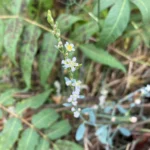Πολύγωνο το αλογοουρόμορφο
Etymology of Polygonum equisetiforme: The name of the genus, "Polygonum" derives from the Ancient Greek compound word "πολύγονο" [polygono] meaning "polygonal", from "πολύ" [poly], meaning "many" and "γόνυ" [gony], meaning "knee" (forming an angle), because of the jointed stems forming many "knees". The epithet derives from Latin "equisetum", which is a genus of plants, and "form", meaning "shape", hence "Equisetum shaped", referring to the species' relevance in appearance with Equisetum. The compound word "equisetum" derives from "equus", meaning "horse" and "seta'' meaning "bristle", which actually means "horse-tail", hence the Equisetum is the "horse-tail plant".
There are at least 4 Polygonum species in the wild Cypriot habitat.
Polygonum equisetiforme is a plant that can pass unnoticed. It is neither common nor rare in the Cypriot habitat. The specific species is encountered all-around Cyprus up to an altitude of 925 metres. It primarily grows on stony hills, roadsides, stream banks and sandy ground, and it usually blooms between April and October.
Polygonum equisetiforme's stems can be up to 300 cm long and 100 cm tall.
Key morphological characteristics of Polygonum equiesetirorme
Polygonum equisetiforme, or horsetail knotweed, is a perennial plant, often with a woody rootstock, sometimes even resembling a subshrub. This distinction in life cycle and stem character is a primary differentiator from P. aviculare and P. patulum. Its stems can be quite long, often procumbent or ascending, and are typically branched. The leaves are lanceolate, and a membranous sheath (ochrea) surrounds the stem at the base of each leaf. The inflorescences of P. equisetiforme are a crucial identifying characteristic: they are typically spiciform (spike-like), terminal, slender, and notably not leafy. The leaves within these inflorescences are much smaller than the stem leaves, creating a clear differentiation in foliage size along the plant. This species is often found in salty soils near the coast, stony hills, roadsides, and stream banks, and its appearance can somewhat mimic that of horsetail plants (Equisetum), which is reflected in its species name.
How to recognize Polygonum equisetiforme among the other Polygonums in Cyprus
Only Polygonum equisetiforme and Polygonum maritimum (grows at 0 metres altitude) are perennial plants with a woody rootstock, and they sometimes even appear like a subshrub.
Equisetiforme's inflorescences are spiciform, terminal, slender, and not leafy. Its leaves are not coriaceous.









